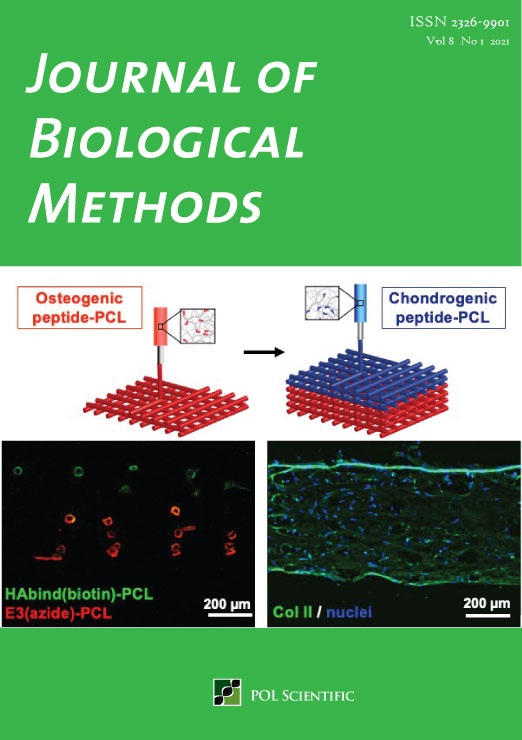Using a variant of the optomotor response as a visual defect detection assay in zebrafish
Main Article Content
Keywords
behavioral neuroscience, optomotor response, spatial frequency, visuomotor, zebrafish
Abstract
We describe a visual stimulus that can be used with both larval and adult zebrafish (Danio rerio). This protocol is a modification of a standard visual behavior analysis, the optomotor response (OMR). The OMR is often used to determine the spatial response or to detect directional visuomotor deficiencies. An OMR can be generated using a high contrast grated pattern, typically vertical bars. The spatial sensitivity is measured by detection and response to a change in grating bar width and is reported in cycles per degree (CPD). This test has been used extensively with zebrafish larvae and adults to identify visual- and/or motor-based mutations. Historically, when tested in adults, the grated pattern was presented from a vertical perspective, using a rotating cylinder around a holding tank, allowing the grating to be seen solely from the sides and front of the organism. In contrast, OMRs in zebrafish larvae are elicited using a stimulus projected below the fish. This difference in methodology means that two different experimental set-ups are required: one for adults and one for larvae. Our visual stimulus modifies the stimulation format so that a single OMR stimulus, suitable for use with both adults and larvae, is being presented underneath the fish. Analysis of visuomotor responses using this method does not require costly behavioral tracking software and, using a single behavioral paradigm, allows the observer to rapidly determine visual spatial response in both zebrafish larvae and adults.
Downloads
Metrics
References
2. Suriyampola PS, Shelton DS, Shukla R, Roy T, Bhat A, Martins EP. Zebrafish Social Behavior in the Wild. Zebrafish. 2016 Feb;13(1):1–8. 26671510
3. Roeser T, Baier H. Visuomotor Behaviors in Larval Zebrafish after GFP-Guided Laser Ablation of the Optic Tectum. J Neurosci. 2003 May 1;23(9):3726–34. 12736343
4. Connaughton VP, Graham D, Nelson R. Identification and morphological classification of horizontal, bipolar, and amacrine cells within the zebrafish retina. Journal of Comparative Neurology. 2004;477(4):371–85.
5. Cameron DJ, Rassamdana F, Tam P, Dang K, Yanez C, Ghaemmaghami S, et al. The Optokinetic Response as a Quantitative Measure of Visual Acuity in Zebrafish. JoVE (Journal of Visualized Experiments). 2013 Oct 9;(80):e50832. 24145465
6. Orger MB, Smear MC, Anstis SM, Baier H. Perception of Fourier and non-Fourier motion by larval zebrafish. Nature Neuroscience. 2000 Nov;3(11):1128–33. 11036270
7. Weber DN, Connaughton VP, Dellinger JA, Klemer D, Udvadia A, Carvan MJ. Selenomethionine reduces visual deficits due to developmental methylmercury exposures. Physiol Behav. 2008 Jan 28;93(1–2):250–60. 17905328
8. Gould CJ, Wiegand JL, Connaughton VP. Acute developmental exposure to 4-hydroxyandrostenedione has a long-term effect on visually-guided behaviors. Neurotoxicology and Teratology. 2017 Nov 1;64:45–9. 29031477
9. Kubo F, Hablitzel B, Dal Maschio M, Driever W, Baier H, Arrenberg AB. Functional Architecture of an Optic Flow-Responsive Area that Drives Horizontal Eye Movements in Zebrafish. Neuron. 2014 Mar 19;81(6):1344–59. 24656253
10. Naumann EA, Fitzgerald JE, Dunn TW, Rihel J, Sompolinsky H, Engert F. From Whole-Brain Data to Functional Circuit Models: The Zebrafish Optomotor Response. Cell. 2016 Nov 3;167(4):947-960.e20. 27814522
11. Dunn TW, Gebhardt C, Naumann EA, Riegler C, Ahrens MB, Engert F, et al. Neural Circuits Underlying Visually Evoked Escapes in Larval Zebrafish. Neuron. 2016 Feb 3;89(3):613–28. 26804997
12. LeFauve MK, Connaughton VP. Developmental exposure to heavy metals alters visually-guided behaviors in zebrafish. Curr Zool. 2017 Apr 1;63(2):221–7. 29491980
13. Lawrence C. The husbandry of zebrafish (Danio rerio): A review. Aquaculture. 2007 Sep;269(1–4):1–20.
14. Peirce JW. Generating stimuli for neuroscience using PsychoPy. Front Neuroinform [Internet]. 2009 [cited 2020 Apr 21];2. Available from: https://www.frontiersin.org/articles/10.3389/neuro.11.010.2008/full 19198666
15. Harmer AM, Thomas DB. pathtrackr: An r package for video tracking and analysing animal movement. Methods in Ecology and Evolution. 2019 Aug;10(8):1196-202.
16. Tauber ES, Atkin A. Optomotor Responses to Monocular Stimulation: Relation to Visual System Organization. Science. 1968;160(3834):1365–7. 5651899
17. Mirat O, Sternberg JR, Severi KE, Wyart C. ZebraZoom: an automated program for high-throughput behavioral analysis and categorization. Frontiers in neural circuits. 2013 Jun 12;7:107. 23781175
18. Portugues R, Engert F. The neural basis of visual behaviors in the larval zebrafish. Current opinion in neurobiology. 2009 Dec 1;19(6):644-7. 19896836
19. Maaswinkel H, Li L. Spatio-temporal frequency characteristics of the optomotor response in zebrafish. Vision Research. 2003 Jan 1;43(1):21–30. 12505601
20. Theobald JC, Ringach DL, Frye MA. Dynamics of optomotor responses in Drosophila to perturbations in optic flow. Journal of Experimental Biology. 2010 Apr 15;213(8):1366–75. 20348349
21. Kist AM, Portugues R. Optomotor Swimming in Larval Zebrafish Is Driven by Global Whole-Field Visual Motion and Local Light-Dark Transitions. Cell Reports. 2019 Oct 15;29(3):659-70. 31618634





